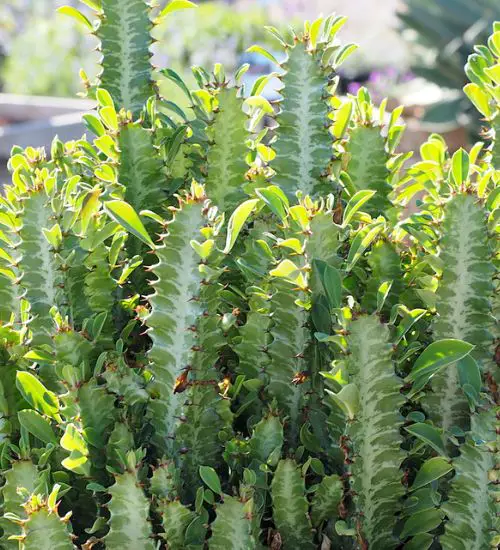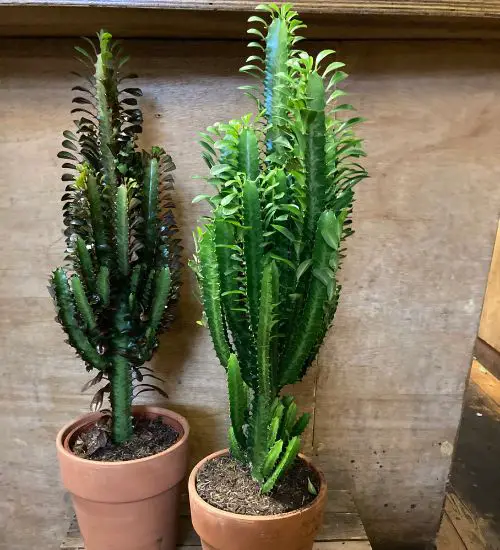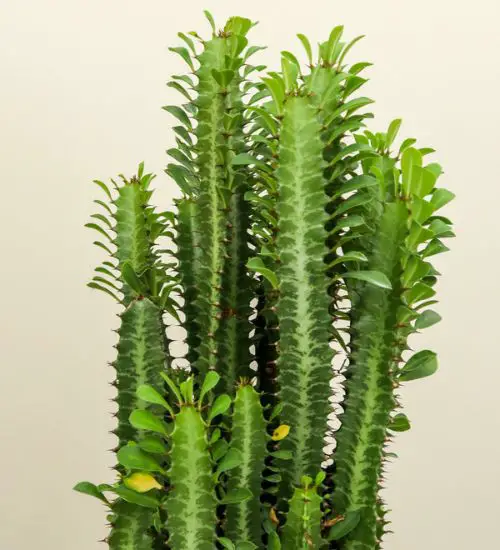Sun: full sun
Water: Below average watering needs for a succulent
Temperature: Zone 10a from 30° F to 35° F (-1.1 ° C to 1.7° C) to Zone 11b from 45° F to 50° F (7.2° C to 10° C)
Winter Survival: Not cold hardy
Propagation: stem cuttings, seeds
Flower: This succulent does not have flower
Toxic: Toxic to humans and animals
Dormant: winter
Space Requirement: Indoors & Outdoors
Common Problems: Plants may rot if overwatered, pests
Where to buy Euphorbia Trigona?
Basc Care for Euphorbia Trigona
Watering
Watering for Euphorbia Trigona is a simple task. It requires Below average watering needs for a succulent.
You can water your succulent more than often in extreme conditions but make sure that the soil is completely dry before watering your succulent again.
Fertilizing
Only feed this succulent during its active growing seasons which means winter. Use the right fertilizer applied in the right amounts. Applying half-strength balanced fertilizer every month or so is recommended for optimal results.
Do not fertilize during winter as the plant is dormant.
Sun & Location Requirements for "African milk tree, cathedral cactus, or Abyssinian euphorbia"
Euphorbia Trigona requires full sun in order to thrive. When choosing a spot for your succulent, make sure it gets at least 6 hours of direct sunlight per day. If the leaves start to look pale or weak, this could be an indication that the succulent isn't getting enough light.
As per this succulent profile, it is only able to stay healthy when the environment temperature is above the range of zone 10a from 30° F to 35° F (-1.1 ° C to 1.7° C).
When temperatures drop below freezing, it is important to take precautions to protect Euphorbia Trigona from the cold. Insulating and providing adequate drainage for the plant are key elements in helping it survive winter weather. Wind and sun exposure should also be minimized to prevent frost damage.
Any succulents in the group will need a medium space to grow. You can place your pot at your table or window. Since this plant needs more space than mini succulents, you should consider do not plant them together with other succulents/plants.
Propagation
Propagating Euphorbia Trigona by stem cuttings is an easy and fun way to increase your collection of these unique houseplants. When propagating, it’s important to choose healthy stems from existing plants that are at least two inches long and have several leaves attached.
Propagating Euphorbia Trigona from seeds is a great way to produce new plants without relying on cuttings or divisions. It's important to look for healthy, dark and plump seeds that are slightly sticky when touched. The soil should be pre-mixed with well-draining potting mix, before evenly sowing the seeds and pressing them into the surface. To ensure successful germination, gentle misting of the soil should be done and placed in indirect light.
Toxicity

All parts of Euphorbia Trigona are considered to be poisonous, and should never be ingested. Even contact with the sap can cause serious skin irritations in humans and animals, so it’s important to wear gloves when handling them.
Pests and Diseases
Euphorbia Trigona can be affected common pests and diseases like most of the other succulents such as mealybugs and scale insects.
If you do spot any of pest signs, you can treat your succulent using below methods.
- Mealybugs: quarantine, clean infected plants, soapy water.
- Scale insects: quarantine, clean infected plants, soapy water.
Besides that, to prevent serious health issues from happening, keep your succulent in a well-ventilated area and check it regularly for any signs of pests or health problems.


